The Creighton men’s basketball staff moved quickly after the transfer portal opened to find Ryan Kalkbrenner’s successor in the post, hosting former Iowa big man Owen Freeman for a visit and securing a commitment.
The 6-foot-10, 245-pound post was the Big Ten Rookie of the Year last season, averaging 10.6 points on 61.4% shooting, 6.6 rebounds and 1.8 assists in 22.9 minutes per game as a freshman. He upped that production to 16.7 points on 63.8% from the field, 6.7 rebounds and 1.8 blocks in 26.4 minutes per game through 19 games as a sophomore before undergoing season-ending surgery for a finger injury. Creighton announced the Freeman addition on Friday.
“We are thrilled to add Owen to our program,” Coach Greg McDermott said in a release. “He is proven scorer at the high major level and is only scratching the surface in terms of his potential. Our offense will allow his versatility to be on full display. We can’t wait to have him in a Bluejay uniform.”
The Athletic’s Sam Vecenie and CJ Moore have Freeman ranked as the 14th-best transfer in the country, making him a big get for the Jays as they transition into the post-Kalkbrenner era of Creighton basketball. To give you a better feel for what the Moline, Illinois, native will bring to Omaha, I dove into his sophomore film at Iowa with the help of Synergy Sports.
Overview
In his abbreviated sophomore season, Freeman produced 1.166 points per possession (PPP), ranked in the 97th percentile nationally (following a freshman season that saw him put up 1.139 PPP, 96th percentile). He’s been one of the most efficient offensive bigs in the country since he first set foot on the court in Iowa City.
Almost all of his offense comes at the rim. Synergy classified just 19 of his 210 field goal attempts as jump shots this season. He was 0-for-2 on mid-range jumpers and 5-for-17 on 3s. Freeman actually shot 5-for-10 on unguarded catch-and-shoot 3s, showing a bit of long-term potential there, but he didn’t make one with a defender closing out. He shot 4-for-8 on runners, showcasing his touch around the basket.
Where Freeman excels, however, is generating shots within five feet of the basket. He shot 14-for-26 on hook shots (ranking in the 86th percentile in efficiency) and 110-156 at the rim (92nd percentile). He was 23-for-24 on dunks and shot 65.9% on layups. Keep these numbers in mind as we dive into more specific play types.
Post-Up
Just over a third of Freeman’s possessions were post-ups and he scored 1.165 PPP (93rd percentile), shooting 62.9% from the field while drawing a foul on 22% of his possessions. He made a big leap in both volume and efficiency from his freshman season, where post-ups made up just under a fourth of his possessions and he scored 0.872 PPP (53rd percentile).
While he can finish with his left, he much prefers his right hand and is better operating from the left block (50 possessions, 1.26 PPP). He can work out of the low or high post as he is comfortable putting the ball on the deck to get to his spots. He works hard for position and seals well to create entry angles. What separates him from other posts is his combination of body control and footwork as he makes use of drop steps, spin moves, pivots and fakes to create scoring opportunities. You can see all of that in the compilation below.
Freeman can get tunnel vision at times and will occasionally try to do too much or over-dribble, leading to turnovers. He’s thinking score every time he catches it, but he did show the ability to find shooters and cutters at Iowa (although other Hawkeyes only shot 3-for-17 from 3 on his post kick-outs, which hurt his assists total).
Pick-and-Roll
While Freeman was primarily a post-up player for Iowa, he set plenty of ball screens as well as pick-and-roll made up 15.1% of his possessions. He scored 1.098 PPP (59th percentile, considered “good”) and shot 55.6%, including 3-of-7 on pick-and-pop 3s. He was actually better as a freshman in the pick-and-roll game, scoring 1.298 PPP (84th percentile) and shooting 66% from the field.
Freeman is often looking to slip screens rather than making solid contact. He has good feel for where to be in the pick-and-roll, finding the gaps and creating passing lanes for his ball-handler. He wasn’t much of a lob threat at Iowa as he’s not a particularly explosive leaper, but he is capable of putting the ball on the deck in short-roll situations to get to the rim. He also began popping for 3s occasionally this season and knocked a few down when his defender gave him plenty of space and time.
Transition
Kalkbrenner ran the floor as well as any 7-footer I’ve ever seen, but Freeman has been even more productive in transition. Fast breaks made up 12.5% of his possessions this season and he scored a blistering 1.743 PPP (99th percentile). He shot 27-of-29 and drew a foul on a fifth of his opportunities. In his two seasons in Iowa City, he shot a combined 50-of-56 from the field in transition.
Freeman is looking to leak out any time he’s not directly involved with a defensive rebound, and he runs the floor well. He’s good at finding space in the open floor and slipping to the rim if teams don’t get matched up. He’s not going to take the 3 as a trailer, but he will put the ball on the floor and attack as the defense is trying to get set. His willingness to run the floor creates mismatches and allows him to set up early post position for easy buckets.
Cut
The abbreviated season limits overall sample size, but he operated as a cutter on 12.5% of his possessions (34 total). He was only average in his efficiency this season (1.176 PPP, 47th percentile), but was better as a freshman (1.377 PPP, 79th percentile on 53 possessions). He shot 63% this season with a 23.5% foul rate.
His lack of explosiveness limited his ceiling in this area, allowing defenders to recover for blocks or to swarm him at times, but he knows how to play off others and make himself available. He’s good in the dunker spot or circling to the front of the rim for dump offs and is an effective baseline out-of-bounds target.
Offensive Rebound
Freeman is active on the offensive glass, grabbing 2.1 boards per game this season. Put-backs made up 9.6% of his possessions and he scored 1.462 PPP (92nd percentile). He shot 81% (17-of-21) with a 19.2% foul rate. For comparison’s sake, offensive rebounds also made up 9.6% of Kalkbrenner’s possessions, and he scored 1.442 PPP (91st percentile).
Freeman runs the floor well to follow up his teammates’ misses, he’s physical carving out space when a shot goes up and he displays a high motor. He does a good job tipping the ball to himself or keeping it alive if he can’t grab it at first. He also sticks with it if he gets blocked, often going right back up with it.
Defense
Freeman looks to be capable of replacing much of what Kalkbrenner gave to Creighton on the offensive end. Defense is a different story. That end of the floor was not a priority at Iowa (to put it mildly; the Hawkeyes finished second-to-last and last in the Big Ten in adjusted defensive efficiency on KenPom during Freeman’s two seasons). It can be difficult to judge a player’s true capability in a dysfunctional system, but Freeman certainly has some limitations on that end.
He has difficulty changing directions and shifting momentum, which is most evident when he attempts to close out on shooters (he often flies by on a pump fake or gets blown by). Often enough he doesn’t put in the effort to close out at all, though whether that’s laziness, a lack of accountability or a scheme thing is hard to tell.
Freeman also struggled mightily to defend in the post this season. While he’s shown the ability to body guys up and stay in front, he’ll also gamble occasionally and take himself out of position. He isn’t terribly undersized, but he isn’t special in that regard Like Kalkbrenner either and oftentimes just lacks the bulk to keep opposing post players off the block or the length to really bother the shot.
One area in which Freeman does show potential is the ability to hedge ball screens and survive on switches. I would not be surprised to see Creighton change its preferred ball screen coverages back to the more aggressive style we saw with Martin Krampelj and Christian Bishop before the Jays switched to drop coverage with Kalkbrenner.
Here are some of his better defensive possessions from this past season.
Freeman isn’t close to the rim protector that Kalkbrenner was (few are), but his biggest strength on defense might be his shot-blocking. He may not be 7-foot-1 with a 7-foot-4 wingspan, but he seems to have terrific timing and hand-eye coordination for blocks. Among his 34 swats this season, I counted 19 in help-side defense, 11 while directly guarding the ball and four in transition including a few chase-down blocks.
Final Thoughts
Kalkbrenner was one of the most efficient scoring big men in Creighton and NCAA history, and in Freeman the Jays landed someone who could come close to matching the 7-footer’s efficiency with his own unique style. The defensive end will require significant adjustments from how Creighton played over the past four years, but I believe he has some untapped potential that different coaching and a better scheme could manifest.
All in all, Freeman was a major first addition in the portal for the Jays, who are reloading for the 2025-26 season.



